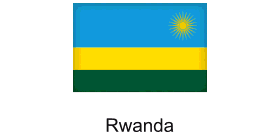 Arrival of white rhinos boosts Rwanda tourism
Arrival of white rhinos boosts Rwanda tourism
Kester Vickery, a conservationist is excited to have been among the group that supervised the translocation of 30 white rhinos from South Africa to Rwanda's Akagera National Park. Billed as the largest single rhino translocation ever undertaken--their journey covered a total distance of over 3,400 kilometres.
And for Vickery-- a co-founder of Conservation solutions-- and her team it was not easy to get enough rest in the past few days.
"It has been a monumental task, getting the rhinos here on a 100 per cent success rate," said Vickery, who was leading a six member team of wildlife experts in the exercise. Some of the 30 newly offloaded white rhinos that were released into Akagera National Park on November 29. Supervised by a six-member team of wildlife experts, the exercise has been billed as the largest single rhino translocation ever undertaken - their journey covered a total distance of over 3,400 kilometres. Photo: Gael Vande Weghe & African Parks.
From South Africa's & Beyond Phinda, a private game reserve, the species were loaded for nearly two and a half hours and taken to Durban Airport, where they could board for Kigali. They landed at the Kigali International Airport in the wee hours of Sunday, before they were transported to Akagera National Park in the Eastern province.
"Once they were offloaded, and left to roam freely, they were very happy and started to feed and sip on water," Vickery asserted. Naturally, he added, they are very calm, usually social animals and primarily bulk grazers.
"They could eat what eight cows would eat per day, so they obviously need lots of bulk grass which Akagera has. There is lots of suitable habitat and food for the rhinos so we see them flourishing and doing well here," Vickery said.
The translocation comes at a time Rwanda is positioning itself as a top Big Five Safari destination.
It also comes as the country's tourism industry, like the rest of the world, is trying to recover from the Covid-19 pandemic.
Big Five Safari, commonly known as Big Five Game, is a group of five most dangerous animals to hunt on food. Akagera National Park is now home to the Big Five--lions, buffalos, elephants, rhinos and leopards.
"It is yet another incredible effort that will propel our recovery from the impacts of Covid-19," Akagera's Park Manager Ladislas Ndahiriwe, told The New Times.
Ndahiriwe disclosed that pandemic left only 50 percent of the park's activities operational, reversing the tourism gains made in 2019.
"The white rhinos arriving is a point of pride for us and for Rwanda. We have created a safe haven that can protect this species for the future."
A big win for the sector
Ariella Kageruka, Ag. Chief Tourism Officer at Rwanda Development Board welcomed the seamless 40 hour journey, stressing that it would not have been possible without the help of experts, and stakeholders especially the Howard G Buffett Foundation.
"Rwanda has recently been on a successful conservation journey. And we are on the right path. In the sense that our conservation is a productive sector in Rwanda, it enables the tourism industry which has been thriving before the Covid-19 pandemic's toll, but also as a source of employment."
Kageruka maintains that adding white rhinos into Akagera national park reaffirms the government's commitment to conservation.
"It also diversifies our tourism offering, as we provide a landscape where animals thrive, and of course visitors will find it attractive and enjoyable to see these animals in wild habitats."
The tourism sector has provided massive benefits for the public, Kageruka argued.
"Through our revenue sharing scheme, we have been working with local communities as direct beneficiaries and direct partners in conservation, where we have worked with them to invest Rwf6.5 billion that have benefited 780 projects, which at the end of the day improve the livelihoods of Rwandans."
This, she said, shows that community led conservation is key to sustainable conservation but also to a thriving eco-tourism industry.
White Rhinos are classified as near threatened, with numbers in decline largely due to poaching, driven by demand for their horns.
They are considered as Africa's most endangered mammals due to extensive hunting for their horns, which are mainly used for ornamental and medicinal purposes.
"It's absolutely vital to get white rhinos spread across the continent, where they have safe habitats, and not necessarily only where they used to be," Jes Gruner, regional director of African Parks told the media.
The African Parks Organisation currently manages Akagera National Park.
"We need to spread the risk. If some countries can't get hold of the illegal wildlife trade, white rhinos and rhinos in general might be pushed to the brink of extinction. We have to do everything we can to address their safety," he added.
Gruner said that Rwanda has shown commitment in conservation and protection in the last 15 to 20 years especially following the reintroduction of black rhinos in 2017.
Much as the majority of wildlife transfers encounter risk, Gruner said that to date no rhino has been poached, and the growth rate has been positive.
"That sets the mark for the white rhinos. We look forward to the day when we have some white rhino calves in Rwanda - 'first generation' Rwandan white rhinos. The day they start multiplying in number, we know this has been a successful project."
The translocation brings the total population of Rhinos in Rwanda to 56, up from none 10 years ago.
